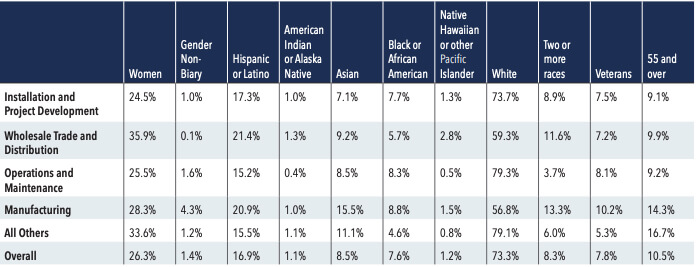 Renewable energy expansion, in which C-PACE has a unique role, is deeply connected to social and economic development. When green energy sources are installed in a building, the larger community benefits from it. According to the Wisconsin Energy Bureau, “investment in locally available renewable energy generates more jobs, greater earnings, and higher output… than a continued reliance on imported fossil fuels.” Because clean energy projects are more labor-intensive, they have the potential to generate thrice as many jobs as a comparable amount spent on fossil fuels. A National Renewable Energy Laboratory study found that renewable investment stays in the community by utilizing craftsmen, handymen, and supplies. Additionally, the green energy field brings development for groups that have not been historically represented in the fossil fuel and coal industries. In 2018, Catalyst, a non-profit dedicated to promoting equality in the workplace, found that women account for less than 20% of the workforce within fossil fuel industries. Whereas, in the solar industry, for example, women, minorities, and other historically underrepresented groups also constitute a large portion of it:
Renewable energy expansion, in which C-PACE has a unique role, is deeply connected to social and economic development. When green energy sources are installed in a building, the larger community benefits from it. According to the Wisconsin Energy Bureau, “investment in locally available renewable energy generates more jobs, greater earnings, and higher output… than a continued reliance on imported fossil fuels.” Because clean energy projects are more labor-intensive, they have the potential to generate thrice as many jobs as a comparable amount spent on fossil fuels. A National Renewable Energy Laboratory study found that renewable investment stays in the community by utilizing craftsmen, handymen, and supplies. Additionally, the green energy field brings development for groups that have not been historically represented in the fossil fuel and coal industries. In 2018, Catalyst, a non-profit dedicated to promoting equality in the workplace, found that women account for less than 20% of the workforce within fossil fuel industries. Whereas, in the solar industry, for example, women, minorities, and other historically underrepresented groups also constitute a large portion of it:
As the renewable energy market is worth over $200 billion, American Business Magazine relates, its economic impact on both the local community and traditionally marginalized groups in business is significant.
Likewise, in many cases, the immediate community also benefits from an increased environmental quality of life. For example, installing certain types of green energy reduces the amount of pollution in the air, which benefits everyone — especially those who are unjustly exposed to more than they create. The EPA reports that minorities and people with lower incomes are disproportionately affected by air pollution, even though they create less of it: Those below the poverty line are exposed 35% more than the average American. Coal-fired power plants, meanwhile, produce over 100 million tons of ash each year, with over two-thirds of said amount ending up in unused mines, landfills, and now toxic ponds. Eventually, the metals in the ash leak out of their unsealed storage and contaminate the local drinking water or other community resources, the Union of Concerned Scientists documents. Exposure to such pollution is connected to an increased risk of cancer, heart problems, neurological disorders, reproductive issues, etc.
By investing in clean energy and making it a more economical choice, one can begin to significantly reduce, or even eliminate, one’s dependence on fossil fuels.
Regrettably, climate change is poised to launch both the United States and the world into a major recession. Kimberly Amadeo of The Balance writes, “scientists estimated that, if temperatures only [rise] 2° Celsius, the global gross domestic product [will] fall 15%.” If temperatures reach 4° higher, then the “Global GDP [will decline] by more than 30% from 2010 levels.” During the Great Depression, the GDP dropped by 26.7%. The EPA reports, moreover, that commercial buildings are a significant component of U.S. energy consumption, costing over $190 billion annually and comprising 36% of the U.S.’s electricity usage. Unfortunately, 30% of this energy is “wasted,” and our buildings represent a full 40% of the U.S.’s total carbon dioxide emissions.
However, through Commercial Property Assessed Clean Energy (C-PACE) property owners now have access to an affordable financing alternative to install renewable energy on the properties or simply reduce the wasted energy by implementing energy efficiency improvements like building controls, high-efficiency lighting (LED), HVAC replacements, etc. To-date, Greenworks has assisted hundreds of building owners in implementing “greener” strategies for their buildings to save energy and reduce their operating expenses. By the second quarter of 2020 , Greenworks Lending helped create 2,940 jobs, and 1,236,631 MWh lifetime energy was saved. As of June 2020, the lifetime projected energy savings for projects financed by Greenworks surpassed $380M. Meanwhile, IRENA, the International Renewable Energy Agency, estimates that doubling the number of renewable energy sources installed by 2030 would “increase global GDP by up to 1.1% or USD 1.3 trillion.” By doing so, the number of jobs connected to the industry would grow by an additional 24.4 million. Thus, C-PACE is an effective means of reducing carbon emissions generated by commercial properties, and it can be a valuable factor in stimulating the U.S., and through it the global, economy.
Clean energy programs, such as C-PACE, are also a crucial component of economic development in towns and cities across the country. C-PACE is repaid through a voluntary tax assessment on the property, creating a credit enhancement for the premises and unlocking a new form of capital for low-mid market property owners who may be struggling to access additional financing – which is further compressed in secondary and tertiary markets. Even when building owners can access financing, banks often require a significant down payment and to be repaid over 5-7 years, which can erode any utility savings benefits from an energy efficiency project. Whereas, with C-PACE, property owners can access zero-money-down, long-term (20-30 years), fixed-rate, non-recourse financing. Further, these financing options complement any solar or energy efficiency improvements, as the utility savings often outweigh the annual debt service, thereby making the cash flow positive project. The U.S. Department of Energy supports this idea by stating that “C-PACE strengthens the business case for investment in longer payback and deeper building retrofits beyond what is possible with traditional financing.”
Finally, C-PACE is also now able to provide capital for new construction projects that demonstrate they are building above code minimum standards or that they meet “green” building certifications, such as LEED or ENERGY STAR. Through its competitive pricing, C-PACE can support property developers by providing cheaper alternatives to mezzanine debt or preferred equity, lowering the barrier to entry for constructing commercial buildings in towns and cities across the country. By doing so, it can help local communities that want to improve older buildings, develop new state-of-the-art properties, and meet aggressive climate change goals to reduce our overall carbon footprint. Now, through C-PACE, numerous communities that would otherwise not receive the benefits of green energy can now do so. It is a valuable and effective means of spurring social, economic, and environmental change.
___________________
Kathryn Murphy is Greenworks Lending’s Business Development Intern and a rising senior at Georgetown University.

